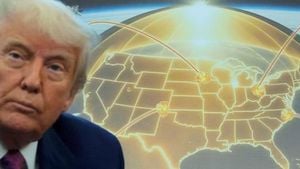Huawei’s recent launch of the Mate 70 smartphone signifies more than just the introduction of another device—it marks a significant moment within the broader U.S.-China tech rivalry. The Mate 70 series, equipped with Huawei’s unique HarmonyOS NEXT and the advanced Kirin 9100 processor, is setting new benchmarks for innovation, resilience, and independence from Western technologies.
With the Mate 70, Huawei aims to establish itself firmly within the tech space, particularly as tensions between the U.S. and China continue to influence global technology markets. This smartphone doesn’t merely incorporate cutting-edge features; it symbolizes China’s increasing self-reliance and ambition to lead the way technologically.
The Mate 70’s most notable advancement is its proprietary Kirin 9100 processor, which is produced by the Semiconductor Manufacturing International Corporation (SMIC). This move away from reliance on U.S. chip technology highlights Huawei’s strategy to assert independence and adapt to the restrictions placed by the U.S. government.
Traditionally, Huawei smartphones have operated within the Android ecosystem, but the switch to HarmonyOS NEXT is pivotal. This operating system not only serves to distance Huawei from U.S. technology but also offers unique functionalities including enhanced performance, improved app compatibility, and smoother integration with various devices across Huawei’s ecosystem, which now includes electric vehicles and smartwatches.
The technological upgrades featured with the Mate 70 are remarkable. The new operating system is said to provide users with up to 40% enhanced performance compared to previous versions, which is quite substantial for consumers who demand efficiency and speed. The phone is also the first to include satellite communication capabilities, allowing users to send messages from remote locations lacking cellular coverage. This feature adds another layer of independence, ensuring connectivity even where networks fail.
One of the most engaging aspects of the Mate 70 is its integration of generative artificial intelligence, which enhances user experience with real-time transcription and translation features. This innovation presents the Mate 70 as not just another smartphone, but also as a powerful tool capable of easing communication barriers and simplifying tasks, thereby making it more attractive to potential users.
While the Mate 70 shows promise, it does face some challenges. The reliance on local manufacturers like SMIC raises concerns about scaling production effectively, especially as these manufacturers may not yield as high results as their global counterparts. The challenge extends beyond hardware; attracting app developers to create applications for HarmonyOS NEXT will require significant investment and community engagement, which are not guaranteed.
The broader implication of the Mate 70's launch is its potential to reshape the narrative of the U.S.-China tech war. This smartphone acts as more than mere tech—a powerful statement asserting China’s capability to innovate and compete against U.S. tech giants. For global markets, it shifts the focus from the current reliance on iOS and Android systems, potentially heralding the rise of diversified technology ecosystems.
Technologically, it is interesting to note how the Mate 70 introduces features reminiscent of technologies we've often seen only in films. The hand gesture-based file transfer, where users can transfer files simply by making a grabbing motion near the screen, has been noted by critics as reminiscent of using the Force from the Star Wars universe. Such fun features bridge innovation with user engagement, promising to attract attention across consumer demographics.
This new file transfer capability is reminiscent of Apple’s AirDrop, adopting gesture control for seamless interactions. Though primarily available within China, the excitement around this feature could inspire other tech companies to innovate with similar capabilities.
Despite the inevitable excitement surrounding its launch, the Mate 70 isn’t expected to reach U.S. consumers due to the current geopolitical climate and trade restrictions. Accordingly, the phone and its advanced functionalities seem set to remain largely within Chinese borders, where they will compete directly with established lines like the iPhone 16.
Huawei’s innovation efforts, particularly with the Mate 70 series, reflect not only the company's resilience but also broader ambitions within China to lead technological breakthroughs. This smartphone has the potential to redefine consumer expectations and serve as the bedrock for future advancements within Huawei and the broader tech industry.
Looking at the Mate 70 and its capabilities, it’s clearer than ever how technology intertwines with geopolitics. This launch signifies more than just the introduction of another smartphone; it signals the deepening struggle for technological supremacy and the lengths to which companies like Huawei are willing to innovate to circumvent international constraints.
Whether the Mate 70 can gain traction beyond China's borders remains to be seen, but its advent undoubtedly raises questions about the future dynamics of global tech. Whatever the outcomes, it's safe to say the smartphone market is on the brink of unprecedented changes due to political tensions, innovation races, and shifting consumer preferences.
So, as consumers worldwide keep their eyes on the tech scene, the Huawei Mate 70 you might never hold could influence the devices you eventually do. The echo of this launch will undoubtedly resonate throughout the tech world as the U.S.-China rivalry continues to evolve, driving innovation to new peaks.



